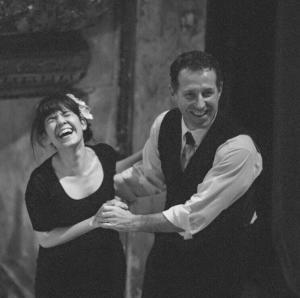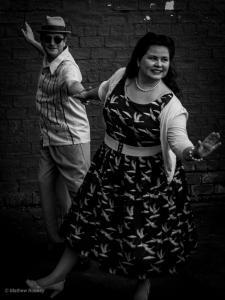British politicians are the bad jazz musicians of Europe. Smugly self-absorbed, they honk tone-deaf, repetitive solos out all time and tune with their confused, Continental colleagues. Their nationalistic noodling sounds like a unilateral rejection of all things foreign—but Britain just can’t shake one very American addiction.
Swing dancing is bigger here now than ever before. Huge cities and little hamlets have lively scenes, each with whole gangs of dedicated dancers. Even small groups hold regular meetups, usually drawing dozens. Many run weekend-long festivals, hosting dancers from across Europe. Global dance calendar SwingPlanIt had 22 major UK events listed at the time of writing—a curious concentration when the US (five times as populous) lists 38. Chances to Lindy hop, Balboa, shag and/or blues dance are spread widely across this little island.
Our unwavering obsession with World War Two, Winston Churchill and “we shall fight on the beaches” must bear some responsibility. Britain got its first shot of swing dance from Whitey’s Lindy Hoppers, who toured Europe in 1935 (featuring Norma Miller) and 1937 (featuring Frankie Manning). It was popularised by US GIs from 1942, but soon went out of fashion—right up until 1983.
That was when ‘Mama Lu’ Parks, guardian angel of the Savoy’s iconic Harvest Moon Ball, brought her Traditional Jazz Dance Company and gave us a much-needed booster. Then native dance teachers—like the late Sue Freeman, from whom I was lucky enough to learn—embraced and encouraged this authentic swing revival. As a relative newcomer, I’m not best placed to tell the history. But the current ubiquity of swing dance in Britain is plain to see.
Of course, the capital is a hopping hotspot. Swing Patrol, London’s leading scene, hosts 30 classes per week and has over 17,000 Facebook followers. They have taught at both Buckingham and Westminster Palaces—even the Queen jitterbugs, it seems.

Scott Cupit is Swing Patrol’s dancing don. Having founded the firm in Melbourne, Australia he moved to London where it is now synonymous with swing dance.
“More people are swing dancing now than ever before,” he said. “Most people try it after seeing it. And it’s much easier to see it now than it ever has been.”
Scott sees more similarities than differences, internationally, though the Old Country does have some curious quirks.
“Dancers in the UK are so young, as scenes are often university societies,” he said. “But the main difference is the fashion. Since moving here I’ve bought a dozen suits. You’d never be able to wear them in Australia—it’s too hot. Back home, people are dancing in shorts and flip flops. It’s much more casual.”
He added: “There are great dancers across the board because they can dance every night of the week. t’s such a small island, people can travel all over for workshops and socials. In London, they can access top teachers from around the world. The standard of dancing there is just off the chart.”
While several styles are danced here, Britain seems especially attached to Lindy hop. With some exceptions, a ‘swing dance’ camp is a Lindy weekend—with solo jazz, shag and other classes as add-ons or tasters. “In Melbourne we do balboa, collegiate shag and blues early on, so students are more aware of them than here,” said Scott. “In Berlin they also do St Louis shag—you don’t see much of that here, or anywhere else.”
Cat Foley also spotted differences between British and German dance. The globetrotting teacher from Liverpool spent six months teaching in Heidelberg.
“They don’t learn many patterns early on, but lots of mixing rhythms and communicating that between partners,” she said. “It can make social dancing quite dry, early on, but there’s an amazing technical understanding—no need for the ‘how do you lead X’ conversations, as that was lesson one.”
Brits dancing in the Continent might be perplexed (and tired out) by the strange ‘two-dance rule’ our European neighbours seem so fond of. Here, one dance and move on is the norm—though invitations for a second are well-received.
“People [over there] tend to have two dances with each person,” said Cat. “It gives them a chance to find each other, connection-wise. It’s not a set rule, like it seems to be at [Swedish swing dance mega-camp] Herrang. And at a shorter event people often just dance once, to get around as many partners as possible.”

How about transatlantic dance differences? Carla Baldwin-Campbell was born in Olympia, WA but now teaches in Scotland, with husband Stuart Campbell. They were busy organizing Glasgow Shag Festival 2019, Britain’s first dedicated shag weekender when she spoke to me last month.
“I’ve danced Lindy hop in Washington, Tennessee, New York, Florida and elsewhere,” she said. “For a long time I couldn’t understand why Americans danced strictly six-beat footwork. Basic eight-count footwork is the very first thing we always teach in Scotland—in the States it just didn’t seem to exist.”
Carla eventually traced this difference back to the classes where US dancers were beginning their swing dance journeys. While UK swing segregates itself from ballroom and Latin, with dedicated schools and scenes, mixing is more common in the US.
This trend goes back to the 1940s when enterprising American ballroom teachers codified Lindy hop to attract new students and facilitate competition, creating East Coast swing. This style emphasizes the ‘easier’ six-count rhythm, which takes a back seat to eight-beat in traditional Lindy.
“In the US, Lindy hop is often taught alongside foxtrot, salsa and so on,” says Carla. “It shows in people’s dancing when Latin steps and rhythms come through. I was trying to dance the Lindy hop I had learned here with people there, but it didn’t look or feel like the dance I knew. It was a bizarre experience.”
This odd experience of Lindy hop is limited to small-town dancing, Carla adds—the big US Lindy hop festivals are hotbeds of Savoy-style dancing.
For all our recent frostiness, Britons are also slightly more likely to meet up for a dance and a beer. “I’ve spent half my life in the States and half here,” Carla says, “I’d say British dancers are slightly more into socializing than over there.”
This could have something to do with the relative ease of finding a dance on this tiny island, compared with Carla’s home nation.
“Some US states don’t host any weekenders at all,” she said. “Here were all crammed into this tiny landmass the size of California and festivals are everywhere.”
Four years after first learning Lindy hop, Carla and Stuart decided to start teaching it. They have since discovered and fallen in love with another American classic—shag.
“That’s something which is only just coming back in the States,” she said. “It’s not as common there as in the UK. It was virtually non-existent, for a while. But that’s changing for the better, with LA Shag Fest, Empire Shuffle in Washington, Hot Rhythm Holiday in Texas, and so on.”
So there you have it—a whirlwind tour of weird UK swing dance. We start young, favor Lindy hop and rarely mix dance styles, though we do get on with our neighbors. We dress up for the occasion and get out often, frequently in other scenes. But we’ll and only dance with you once, before moving on. We hope that doesn’t make us sound snobbish or unfriendly. We’d really like you to come over here and dance with us—whatever bum notes Westminster is playing.
Dave Doyle is a swing dancer, dance teacher, and journalist based in Gloucestershire, England. Write him at davedoylecomms@gmail.com. Find him on Twitter @DaveDoyleComms.






















